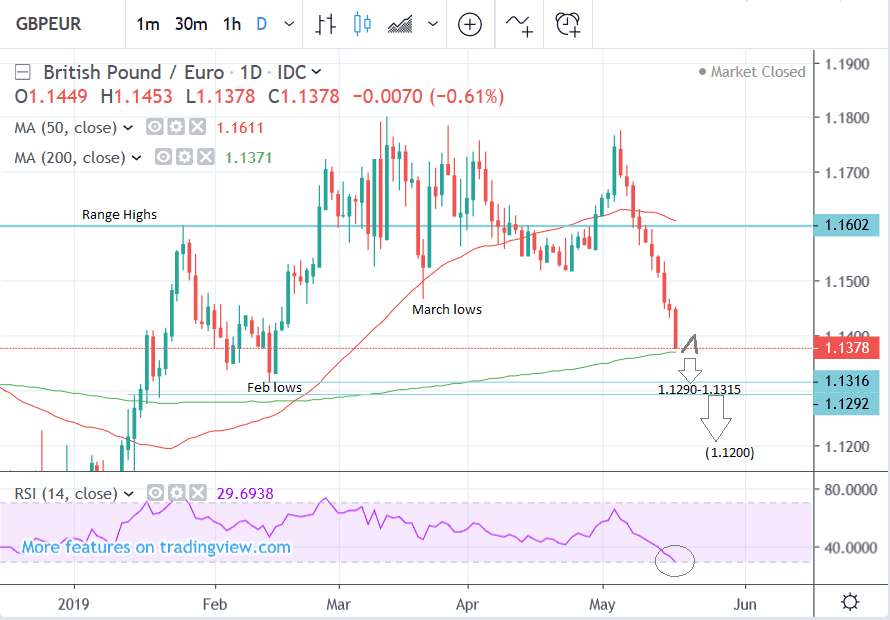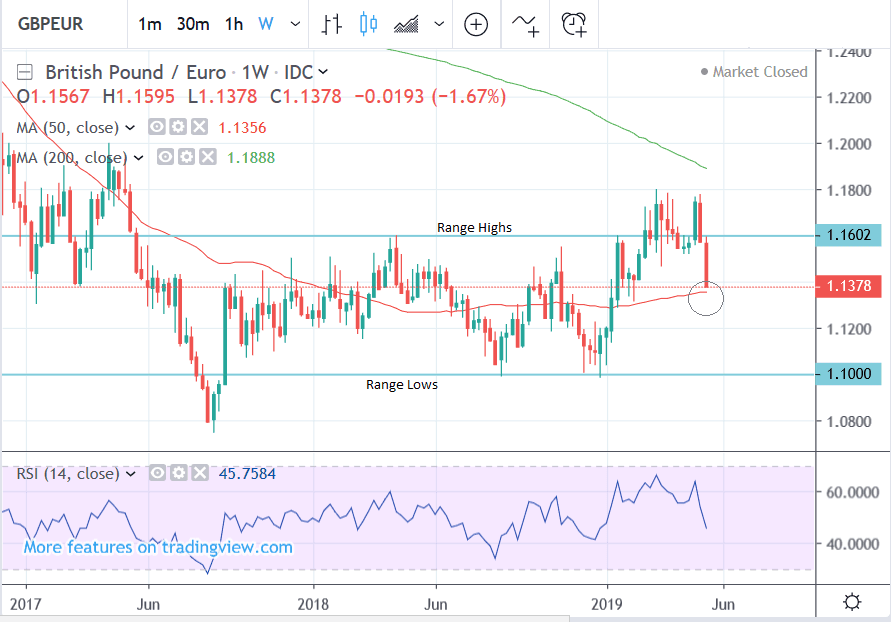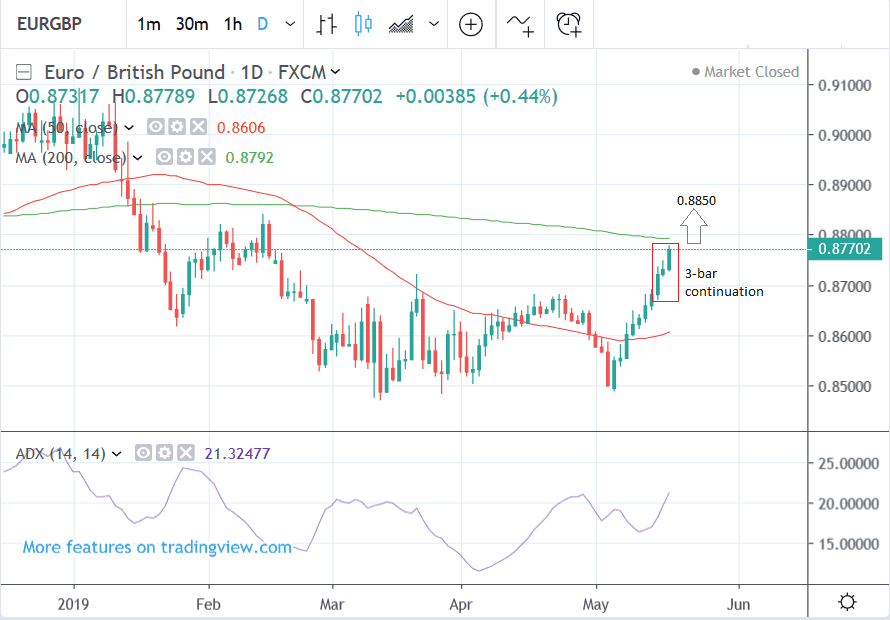Pound-to-Euro Exchange Rate 5-Day Forecast: Oversold, Could Bounce Short-Term but Overarching Theme is one of Weakness

Above: Jesus Carmona, Director for the Media, European Parliament, Brussels gives a technical briefing on the EU elections. Photo by Benoit Bourgeois, Copyright © European Union 2019 - Source: EP
- GBP/EUR in concerted downtrend
- 200-day could provide support
- Growing 'no deal' Brexit odds to drive Sterling
- Euro to eye PMIs
Pound Sterling has fallen sharply against the Euro over the past 2-weeks: from trading at peak of 1.1776 at the start of May it has fallen 4 whole cents to 1.1378; all in the space of just 10 days.
The exchange rate is in the midst of its worst losing streak in its history having registered 10 days of unanswered declines.
The decline has come about as a result of the collapse of cross-party Brexit talks which had promised to deliver a possible softer ‘customs-union’ Brexit as well as the realisation the UK will have a new leader by the end of summer, with polls suggesting Boris Johnson - a Brexit 'hawk' - is the favoured replacement of Prime Minister Theresa May.
From a technical perspective, the pair is in an established downtrend which is expected to extend.
There is a heightened risk of a short-term pull-back as on some readings the exchange rate is oversold; but eventually the dominant short-term bear trend, which has taken hold over May, will probably continue to drag the exchange rate lower.
The RSI momentum indicator is now in oversold territory which is a sign of a heightened chance the trend my run out of steam, or bounce. The proximity of the 200-day reinforces the likelihood of a pullback.
GBP/EUR has reached the 200-day moving average (MA) which will almost certainly result in a marginal bounce - probably even a full scale pullback as is often the case when exchange rates meet such significant technical barriers.
Here we would expect traders to layer orders to sell or buy the currency, which could disrupt the recent trend.
So beware short-term rallies, but the overall bias is lower.
An eventual continuation lower is probable.
The first downside target for GBP/EUR is at 1.1315 where the February lows are situated. A further downside target is 1.1290 based on the translation of the target for the 3-bar continuation on EUR/GBP. Eventually we see a probably move all the way down to a target at 1.1200, and perhaps even 1.1100 and the lower regions of the broader multi-year range shown in the weekly chart below.
A clear break below the 200-day MA would provide bearish confirmation of these continuations. Initially this would be signalled by a break below 1.1350 followed by 1.1340 and 1.1330. Each break would add downside conviction to the outlook. A daily break on a closing basis would also provide confirmation.
The EUR/GBP chart, which is GBP/EUR priced from the perspective of how many Pounds one Euro can buy, is showing the completion of a high probability 3-bar continuation pattern.
This, combined with rising ADX above 20 is a very strong sign of continuation of the uptrend (downtrend for GBP/EUR).
Whilst the proximity of the 200-day MA is providing resistance to the Euro at the highs, we expect this to merely delay the eventual continuation higher, not cease it.
The likelihood is that after a few days of sideways consolidation, the pair will eventually breakout higher, fulfilling the promise of the 3-bar set-up.
Time to move your money? Get 3-5% more currency than your bank would offer by using the services of foreign exchange specialists at RationalFX. A specialist broker can deliver you an exchange rate closer to the real market rate, thereby saving you substantial quantities of currency. Find out more here.
* Advertisement
The Pound this Week: Euro Elections, Inflation Data
Overshadowing most data for Sterling will probably be Brexit risks and political uncertainty from the EU elections.
The Pound has nosedived since news cross-party talks fell apart. One catalyst for the disintegration has been the strong support polled by the new Brexit Party in the run up to the EU elections, on Thursday May 23, and correspondingly weak support polled by the Conservatives.
The inference is that Tory voters have changed allegiances and joined the Brexit party. This seems to be hardening the Conservative Party's stance on Brexit, widening the gulf between them and the other major parties.
Pressure is now also growing for the Prime Minister to resign, especially if her deal fails its fourth and final meaningful vote at the start of June, and Boris Johnson, who is a Brexit 'hawk', is the frontrunner to take over.
If he does it will increase the risks of ‘no-deal’ as we believe the next Prime Minister will pursue a policy of 'Brexit at all costs' come October 31.
“A poor showing by the UK Conservatives in the European Parliament elections could make it even more likely that Theresa May is replaced with someone that wants to deliver Brexit ‘no matter what’, keeping the Pound on the back foot,” says Raffi Boyadijian, an economist at FX broker XM.com.
Other events, however important during ‘normal’ times, are likely to be overshadowed by political risks, even inflation data out at 9.30 BST on Wednesday, May 22, and the testimony of the governor of the Bank of England (BOE), Mark Carney at 9.30 on Tuesday, May 21.
Inflation is expected to show a big rise in April, increasing by 0.7% on a monthly basis and 2.2% compared to a year ago. This would reflect a considerable acceleration from March when inflation only rose by 0.2% and 1.9% respectively.
Core inflation, which strips out volatile food and fuel components, is forecast to rise by 0.4% month-on-month and 1.8% compared to a year ago. This compares to 0.2% and 1.8% respectively in March. The core figure is not expected to show the same acceleration as broad CPI, as inflation recently has been driven primarily by rising oil prices, which impact on petrol prices.
Commentary from the governor of the BOE, Mark Carney, and other members of the BOE rate-setting committee, also potentially moving markets.
Although Governor Carney’s comments to the Parliamentary treasury committee may move the Pound, heightened Brexit uncertainty may make him ambivalent, and there is a risk of a U-turn from his May meeting confidence when he said investors should guard against complacency over inflation. The BOE’s stance at its May policy meeting was that it planned to raise interest rates over coming months at a "gradual and limited" pace.
Retail sales data is the final major release on the calendar, and is forecast to show a -0.4% slowdown from March, partly because of the outlying stellar performance in April when it rose 1.4%. It is forecast to rise by 4.6% compared to a year ago, after it grew 6.7% in March compared to the previous year. If sales are strong it could boost the Pound as it will show consumers continue to spend generously, which is a key indicator of overall economic growth for a nation.
The Euro: What to Watch this Week
The main events for the Euro in the coming week are the release of Eurozone PMI survey data for May, which markets use as a leading indicator for economic growth, and the start of the EU elections in some parts of the region, although the voting won’t officially conclude until Sunday.
The Eurozone May Composite PMI is forecast to show a rise to 51.7 from 51.5. The Manufacturing PMI is forecast to recover to 48.2 from 47.9, but remain in contraction mode (signified by a result below 50). Services sector PMI is expected to rise to 53.0 from 52.8. The data could be key to the Euro.
“Perhaps the most crucial release of the week, will be the Eurozone’s preliminary PMIs for May – out on Thursday. Euro area growth has struggled in recent quarters, leading the European Central Bank (ECB) to put its rate-hike plans on ice and consequently hurting the euro. In fact, investors believe the normalisation ship has sailed, with money markets now suggesting a small probability for an ECB rate cut this year, not a hike,” says Raffi Boyadijian, an economist at XM.com.
There is the potential for political risk to impact on the Euro as countries vote in the EU elections starting on May 23.
Signs of big swings to Eurosceptic parties is a risk to the Euro as it would bring into doubt plans for greater integration which would probably benefit the currency.
Time to move your money? Get 3-5% more currency than your bank would offer by using the services of foreign exchange specialists at RationalFX. A specialist broker can deliver you an exchange rate closer to the real market rate, thereby saving you substantial quantities of currency. Find out more here.
* Advertisement







